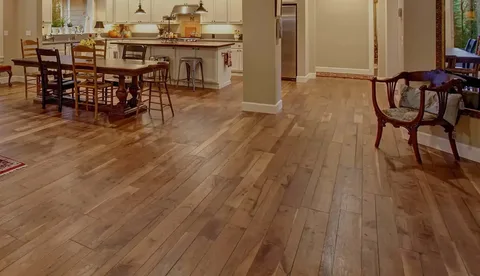Wood flooring adds timeless beauty and warmth to any space. However, selecting the perfect finish is crucial to both protecting the wood and enhancing its natural charm. In this guide, we’ll explore how to choose the right finish for your wood flooring so that it not only looks stunning but also stands the test of time.
Understanding Wood Flooring Finishes
Before diving into the selection process, it’s important to understand the common types of finishes available:
- Oil-Based Polyurethane: Durable and offers a warm, amber tone.
- Water-Based Polyurethane: Clear finish that dries quickly and resists yellowing.
- Wax: Provides a natural, low-sheen look but requires regular maintenance.
- Penetrating Oil Finishes: Absorbs into the wood, enhancing grain and providing a matte finish.
- Aluminum Oxide: Extremely durable, often factory-applied for prefinished wood floors.
Each finish type has its unique benefits and drawbacks, which brings us to the key considerations when deciding on the right finish.
Factors to Consider When Choosing a Finish
1. Durability and Wear Resistance
If your wood flooring is in a high-traffic area like hallways or kitchens, you’ll want a finish that can withstand scratches, spills, and daily wear. Polyurethane finishes, especially oil-based and aluminum oxide, are excellent for their long-lasting protection.
2. Aesthetic Preferences
Do you prefer a glossy, shiny look or a more natural matte appearance? Oil-based finishes tend to deepen the wood’s color and add warmth, while water-based finishes keep the floor’s natural color with less yellowing over time. Penetrating oils offer a soft, natural feel without the plastic-like coating.
3. Maintenance Requirements
Some finishes require more upkeep than others. For example, wax finishes need regular reapplication, whereas polyurethane finishes are relatively low-maintenance. Consider how much time and effort you’re willing to spend maintaining your floors.
4. Environmental and Health Concerns
If you’re sensitive to odors or prefer eco-friendly options, water-based polyurethanes or natural oils with low VOCs (volatile organic compounds) are safer choices compared to traditional oil-based products.
How to Choose the Right Finish for Your Wood Flooring: Step-by-Step
Step 1: Assess Your Lifestyle and Flooring Location
Think about the room’s traffic level, moisture exposure, and daily activities. For busy family homes or pet owners, durability is key.
Step 2: Decide on the Desired Look
Visit showrooms or review samples to see how each finish affects the wood’s tone and sheen. This helps narrow down your preferences.
Step 3: Evaluate Maintenance Commitment
Choose a finish that aligns with the amount of care you’re ready to provide to keep your floor looking fresh.
Step 4: Consider Environmental Factors
Opt for finishes that meet your health and eco-conscious standards.
Conclusion
Knowing how to choose the right finish for your wood flooring can dramatically impact both the longevity and beauty of your floors. By considering durability, aesthetics, maintenance, and environmental factors, you can make an informed decision that enhances your home’s ambiance for years to come. Whether you opt for the timeless appeal of oil-based polyurethane or the modern clarity of water-based finishes, the right finish will protect your investment and highlight the natural elegance of your wood flooring.


